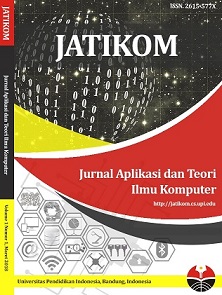Implementasi Metode Machine Learning menggunakan Algoritma Evolving Artificial Neural Network pada Kasus Prediksi Diagnosis Diabetes
Abstract
Keywords
Full Text:
PDFReferences
World Health Organization, “The Top 10 Causes of Death,” World Health Organization (WHO), 2018. [Daring]. Tersedia pada: https://www.who.int/news-room/fact-sheets/detail/the-top-10-causes-of-death.
World Health Organization, “Diabetes: Fakta dan Angka di Indonesia,” 2016. [Daring]. Tersedia pada: http://www.searo.who.int/indonesia/topics/8-whd2016-diabetes-facts-and-numbers-indonesian.pdf.
M. M. Roche dan P. P. Wang, “Factors associated with a diabetes diagnosis and late diabetes diagnosis for males and females,” J. Clin. Transl. Endocrinol., vol. 1, no. 3, hlm. 77–84, Sep 2014, doi: 10.1016/j.jcte.2014.07.002.
International Diabetes Federation, IDF Diabetes Atlas Ninth edition 2019, 9 ed. International Diabetes Federation (IDF), 2019.
International Diabetes Federation, IDF Diabetes Atlas Eighth edition 2017, 8 ed. International Diabetes Federation (IDF), 2017.
S. Shanmuganathan dan S. Samarasinghe, Ed., Artificial Neural Network Modelling, vol. 628. Cham: Springer International Publishing, 2016.
J. V. Tu, “Advantages and disadvantages of using artificial neural networks versus logistic regression for predicting medical outcomes,” J. Clin. Epidemiol., vol. 49, no. 11, hlm. 1225–1231, Nov 1996, doi: 10.1016/S0895-4356(96)00002-9.
S. Pratomo dan R. N. Dayawati, “Implementasi Metode Time Series Menggunakan Algoritma Evolving Artificial Neural Network Pada Kasus Peramalan Saham Implementation Of Time Series Method Using Evolving Artificial Neural Network In Stock Forecasting,” hlm. 6, 2009.
X. Yao, “Evolving Artificial Neural Networks,” Proc. IEEE, vol. 87, no. 9, hlm. 25, 1999.
J. Loy, Neural network projects with Python: the ultimate guide to using Python to explore the true power of neural networks through six projects. 2019.
I. P. D. Lesmana, “Pengembangan Decision Tree J48 Untuk Diagnosis Penyakit Diabetes Mellitus,” hlm. 5, 2012.
A. Setiadi, “Penerapan Algoritma Multilayer Perceptron Untuk Deteksi Dini Penyakit Diabetes,” no. 1, hlm. 14, 2012.
R. N. Fatimah, “Diabetes Melitus Tipe 2,” J Major. Med. Fac. Lampung Univ., vol.
, no. 5, hlm. 9, Feb 2015.
P. E. I. PERKENI, “Konsensus Pengelolaan dan Pencegahan Diabetes Melitus Tipe 2 Di Indonesia.” PB. PERKENI, 2015, [Daring]. Tersedia pada: https://pbperkeni.or.id/wp-content/uploads/2019/01/4.-Konsensus-Pengelolaan-dan-Pencegahan-Diabetes-melitus-tipe-2-di-Indonesia-PERKENI-2015.pdf.
A. V. Joshi, Machine Learning and Artificial Intelligence. Cham: Springer International Publishing, 2020.
B. Xu, H. Lin, K. B. Wagholikar, Z. Yang, dan H. Liu, “Identifying protein complexes with fuzzy machine learning model,” Proteome Sci., vol. 11, no. Suppl 1, hlm. S21, 2013, doi: 10.1186/1477-5956-11-S1-S21.
L. Fausett, Fundamentals of Neural Networks: Architectures, Algorithms, and Applications. Prentice-Hall, 1994.
V. Zhou, “Machine Learning for Beginners: An Introduction to Neural Networks,” Jul 24, 2019. https://victorzhou.com/blog/intro-to-neural-networks/.
DOI: https://doi.org/10.17509/jatikom.v6i1.56536
Refbacks
- There are currently no refbacks.
Copyright (c) 2023 Universitas Pendidikan Indonesia (UPI)

This work is licensed under a Creative Commons Attribution-ShareAlike 4.0 International License.
JATIKOM is published by Universitas Pendidikan Indonesia
Jl. Dr. Setiabudhi 229 Bandung 40154, West Java, Indonesia
Website: http://www.upi.edu













